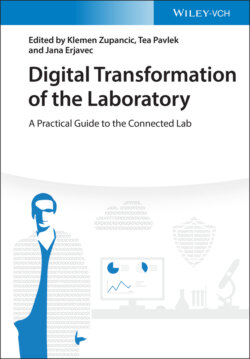Читать книгу Digital Transformation of the Laboratory - Группа авторов - Страница 4
List of Illustrations
Оглавление1 Chapter 1Figure 1.1 Complex, multivariate concept of lab transformation.Figure 1.2 Virtual and real design‐make‐test‐analyze (DMTA) concept.Figure 1.3 Hypothesis‐experiment‐analyze‐share (HEAS) cycle.Figure 1.4 Request‐experiment‐analyze‐feedback (REAF) process.Figure 1.5 Digital data life cycle.
2 Chapter 2Figure 2.1 The Von Neumann architecture.Figure 2.2 Operating system's role in modern computers.Figure 2.3 On‐site setup.Figure 2.4 Cloud setup.Figure 2.5 Explanation of the differences between Private, IaaS, PaaS, and S...Figure 2.6 Transformation of data.Figure 2.7 Two options to achieve software interoperability by employing API...Figure 2.8 Diagram 1.Figure 2.9 Diagram 2.Figure 2.10 Diagram 3.Figure 2.11 Most popular open‐source license types.
3 Chapter 3Figure 3.1 Types of software found in the laboratory.
4 Chapter 4Figure 4.1 A list of interfaces/pathways that malicious adversaries can pote...Figure 4.2 A man‐in‐the‐middle attack.Figure 4.3 Differences between the two types of encryption.
5 Chapter 7Figure 7.1 Digital transformation encompasses at least three aspects: people...Figure 7.2 An example of a simple data flow of a laboratory.Figure 7.3 SWOT analysis: Strengths, Weaknesses, Opportunities, and Threats....
6 Chapter 10Figure 10.1 An example of a graphical representation of stakeholder analysis...Figure 10.2 Gradual rollout of a new software solution.
7 Chapter 12Figure 12.1 The different stages of scientific research.
8 Chapter 16Figure 16.1 Organization of projects and experiments in SciNote.Figure 16.2 Example of a different approach to organization of projects and ...Figure 16.3 Example of using Microsoft Office online files in SciNote.Figure 16.4 Team protocols repository in SciNote.Figure 16.5 Choosing to link (or not) the protocol with the version saved in...Figure 16.6 Tracking the day‐to‐day tasks and their completion progress.Figure 16.7 Records of lab technicians' work progress in SciNote.Figure 16.8 Organizing results in SciNote.Figure 16.9 Organizing results in SciNote, under the dedicated Results secti...
9 Chapter 17Figure 17.1 Creating a team in SciNote electronic lab notebook.Figure 17.2 Setting time and date records in SciNote electronic lab notebook...Figure 17.3 Levels of user roles and permissions in SciNote.Figure 17.4 CVTA form no. 49 for change control management (consists of Modu...Figure 17.5 Workflow for change control management in SciNote.Figure 17.6 Example from SciNote – change control, task M1.Figure 17.7 Conclusion of the change – task M2.Figure 17.8 Inventory for change control management.Figure 17.9 Workflow for investigations of OOS results.Figure 17.10 Detailed audit trail within a task, where change in text (old v...
10 Chapter 18Figure 18.1 Examples of the saved results comprising hundreds of image files...Figure 18.2 Folded protein structure in stick and rod representation. Image ...Figure 18.3 Redesign of zinc finger backbone structure.Figure 18.4 Antibody structure in (a) schematic view and (b) cartoon view. I...Figure 18.5 PDB file format and its three‐dimensional structure.Figure 18.6 An example of antibody redesign information saved in the results...
11 Chapter 19Figure 19.1 Enterprise system architecture diagram.Figure 19.2 Simplified physical network diagram.Figure 19.3 Example of a radar chart to measure the laboratory digital matur...
12 Chapter 20Figure 20.1 Schematic representation of connections if all software tools co...Figure 20.2 An example of a typical data workflow map in a “paper‐based” lab...Figure 20.3 An example of a much simpler data workflow in a digital lab afte...
13 Chapter 21Figure 21.1 Artificial intelligence can support laboratories on different po...
14 Chapter 22Figure 22.1 Smart laboratory example.
15 Chapter 24Figure 24.1 Monthly submissions to bioRxiv. Numbers based on: http://api.bio...
